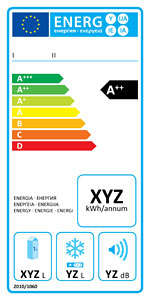
Have you ever seen A++ written on the label of an appliance and wondered what on earth it means? Well if you have, you’re not the first person to do so! We thought it was about time we wrote a piece on what appliance energy ratings mean and what to look out for when you are buying any new kitchen appliances, as they are becoming a more important factor for people when they buy a new appliance.
The scale of energy ratings varies depending on the type of appliance, but it usually runs from A+++ down to G. Below are a few points to make note of for dishwashers, fridges and freezers, washing machines and tumble dryers.
Dishwashers
· Rated from A+++ (the best) to D (the worst);
· If your appliance was purchased before 2011, it could have a G rating which will mean it is very costly to run;
· The rating for dishwashers is calculated by working out how much energy and water is used in the standard program as well as the eco program;
· Energy rating for dishwashers is shown in kilowatt hours per year (kWh);
· Did you know? Washing up dishes by hand may not always be more efficient than using your dishwasher
Fridges and Freezers
· As of 1st July 2012, each new fridge or freezer must have an A+++, A++ or an A+ energy rating (a selection of the best);
· If your appliance was made before September 1999, it could have a rating as low as G (the worst);
· Appliance energy ratings are calculated by comparing energy consumption with the internal volume of your fridge freezer;
· Did you know? Refrigeration products are the second least efficient appliances after central heating in your home.
Washing Machines
· If you own an older appliance it could have a rating of anything from A+++ (best rating) to D (worst rating), making it significantly less efficient;
· Again, like dishwashers, the unit of measurement is kilowatt hours per year (kWh);
· To get an energy rating, tests are done of both full and half full loads on various settings;
· Did you know? In 2014 a rule was introduced stating new washing machines could only have an A+++, A++, A+ or A energy rating, making them very efficient
Tumble Dryers
· How is it measured? Appliance energy ratings for tumble dryers are calculated by monitoring how much energy is used by the appliance in standard cotton drying cycle;
· There are both electric and gas tumble dryers available, and as of 2012, energy ratings were introduced for gas tumble dryers;
· Like the other appliance energy ratings, electric tumble dryers have ratings ranging from A+++ as the most efficient to G for the least efficient;
· Did you know? Gas tumble dryers cost less to run than their electric equivalents
So if you are thinking of buying any new kitchen appliances or other home appliances for that matter, we hope that after this post you will be able to understand the appliance energy rating and get the perfect appliance for your home.